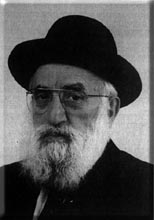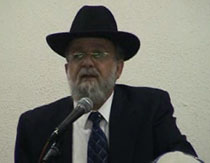Beit Midrash
- Shabbat and Holidays
- Shabbat
- Laws of Shabbat
Yankie’s older brother, Reuven returns from yeshivah and tells his mom that it is okay to tie the baby’s shoes with a double knot. Mom has never done this, always assuming that one cannot tie a double knot on Shabbos, even though baby Rivka’s shoes almost never stay tied on Shabbos as a result. Of course, Yankie does not miss the opportunity to disagree with Reuven and emphasize that one may not tie the shoes on Shabbos just as one may not tie the tichel.
What’s a mother to do?
Last time we learned that some knots are prohibited min haTorah, others are prohibited midirabbanan, while others are completely permitted. Any knot that may not be tied may not be untied either. If tying it involves a Torah prohibition, then untying it is forbidden min haTorah (Mishnah Shabbos 111b). If tying the knot is only midirabbanan, then untying it is midirabbanan. If one is allowed to tie a particular knot, one may also untie it (Rambam Hilchos Shabbos 10:7). We learned that according to Rashi and most Rishonim, it is prohibited min haTorah to tie a permanent knot, midirabbanan to tie a semi-permanent knot, and that it is permitted to tie a temporary knot. Everyone agrees that Rashi permits tying any knot that will be untied within 24 hours from when it is tied (Beis Yosef 317). On the other hand, everyone agrees that Rashi forbids tying a knot that is left untied for a week or more. Authorities dispute whether Rashi prohibits tying a knot meant to last more than 24 hours but less than a week, some viewing this knot as semi-permanent and others as temporary (Rama 317:1). One may follow the lenient opinion under extenuating circumstances (Biyur Halacha 317:4 s.v. she’einam kevuim).
According to Rambam, a knot that is permanent is prohibited min haTorah only when it is a type of knot that a craftsman would use, called a "kesher uman." A permanent knot that would not be used by a craftsman is only midirabbanan. In addition, a knot that a craftsman would tie but is not permanent is also only midirabbanan, whereas a knot that is neither permanent nor used by a craftsman is totally permitted. There is some uncertainty as to what is considered a "craftsman’s knot." Because of this question, some poskim rule that one should not tie any knot very tightly even though one intends to untie it shortly (Shiltei HaGibborim).
According to both Rashi and the Rambam, one may tie a knot that will be untied within 24 hours if it is not extremely tight. Thus according to all opinions, one may tie a gartel on Shabbos or the belt on a bathrobe or any other garment that is usually untied as it is removed and is not tied very tightly. Similarly, a woman may tie her tichel in place because a woman always unties this knot when she removes it so that she does not dishevel her hair.
TYING A KNOT IN A PIECE OF STRING
Tying a knot with a piece of string or length of rope around itself so that it does not slip through a hole or unravel is usually prohibited min haTorah according to all opinions (Gemara Shabbos 74b; Rama 317:1). This knot usually remains permanent and thus is certainly a Torah violation according to Rashi. Even according to the Rambam that only a craftsman’s knot incurs a Torah transgression, this is a very tight knot that a craftsman would use for this purpose. (It is interesting to note that some people call this "a stevedore’s knot," implying that it is a craftsman’s knot.) Thus, tying a knot on a threaded needle to hold it in place is prohibited min haTorah.
For the same reason, making a knot on the end of one’s tzitzis to prevent them from unraveling is prohibited min haTorah. Similarly, it is prohibited min haTorah to tie a balloon on Shabbos. Therefore, some authorities prohibit blowing up a balloon on Shabbos because of the possibility that one may mistakenly tie it.
WHAT IS CONSIDERED A CRAFTSMAN’S KNOT?
The definition of a craftsman’s knot is difficult to ascertain. Obviously it has to be very tight, but are there other requirements? Because of this uncertainty, a custom developed not to tie any knot on Shabbos that involves tying one knot on top of another (Shiltei HaGibborim; Rama 317:1) which is how most knots are tied. Thus, one might assume that Mrs. Goldstein may not tie her tichel with a double knot as Yankie told her.
However, most poskim permit tying the tichel as Mrs. Goldstein has been doing and as her mother did before her. This is because of a combination of several reasons:
Several poskim contend that the custom not to tie a double knot is only when one ties a knot very tightly (L’vushei S’rad and Pri Megadim on Magen Avraham 317:4; also see
Chazon Ish 52:17) whereas a tichel is tied fairly loosely. Other poskim contend that the custom not to tie a double knot is only if one intends to leave it tied for more than a day (Aruch HaShulchan 317:10). Thus there is substantive reason to permit tying a tichel with a double knot (Shmiras Shabbos K’Hilchasah 15:ftn 167).
It should be noted that many poskim permit double knotting a child’s shoes for the same reason since the knot is not very tight. Others prohibit it because the reason for the upper knot is to make the lower knot and bow very tight and that is considered tying a double knot tightly (Shmiras Shabbos K’Hilchasah 15:53).
ANIVAH
The Gemara concludes that it is permitted to tie an "anivah" on Shabbos. What is an anivah?
Any knot that can be untied without undoing the original knot by pulling on one side of the knot is an anivah and is permitted. This includes tying bows (without additional knots, see below) and slipknots (Mordechai, Halachos Ketanos #940). A slipknot is so called because it slips easily along the cord on which it is made.
The poskim dispute whether one may tie a temporary knot and then a bow on Shabbos. Does the bow make the knot more permanent and therefore a problem? Most poskim prohibit tying a bow onto a temporary knot, considering the knot thus created a semi-permanent knot that is prohibited (Rama 317:5; Taz; Magen Avraham ad loc.).
TYING RIBBONS AND BOWS
According to what we have explained, one may not tie a ribbon around a package on Shabbos in the usual fashion because this involves tying a double knot. However, one may tie the ribbon without a knot by making two bows even if one ties the bows very tightly (Mishnah Berurah 317:29; Biyur Halacha 317:5 s.v. anivah).
If someone forgot to tie the aravos and hadasim to the lulav before Yom Tov, one cannot tie with a knot and bow on top of it unless it is a type of knot that one unties every day. One may tie it with a bow on top of a bow (Taz 317:7).
SUMMARY OF KNOTS
We have learned that one may not tie a permanent or semi-permanent knot or a craftsman’s knot, and also that one may not tie one tight knot on top of another. According to many poskim, one may tie a loose knot on top of another loose knot and therefore a woman may tie her tichel with two knots one on top of the other. Tying a bow or slip knot is permitted since the knot is taken apart without undoing it but by pulling it apart. Thus, Mrs. Goldstein may continue to tie her tichel and there are poskim who even permit double knotting baby Rivka’s shoes. (Although others prohibit double knotting shoes.)
PERMANENT BONDING
Tying knots in a permanent way not only affects halacha but also has hashkafic ramifications. When Moshe Rabbeinu asked to understand Hashem’s ways, Hashem told him that as long as he was alive he would only be able to recognize Hashem "from behind." Chazal explain that Hashem showed Moshe the knot of His tefillin, which represents the permanent attachment that exists between Hashem and the Jewish people.
Just as tefillin are tied with a permanent knot, so too Hashem’s relationship with the Jewish people is a permanent bond. And just as the tefillin straps tie what is below to what is above, so too their knot connects our mundane world below to the Heavenly world above.
This Shiur is published also at Rabbi Kaganof's site

Raising Charitable Funds on Shabbat
Rabbi Daniel Mann | 5775

Wanted Dead or Alive
Rabbi Yirmiyohu Kaganoff | 22 Adar II 5784

Cooking for Shabbat at the End of Yom Tov
Rabbi Daniel Mann | Iyar 20 5783






















